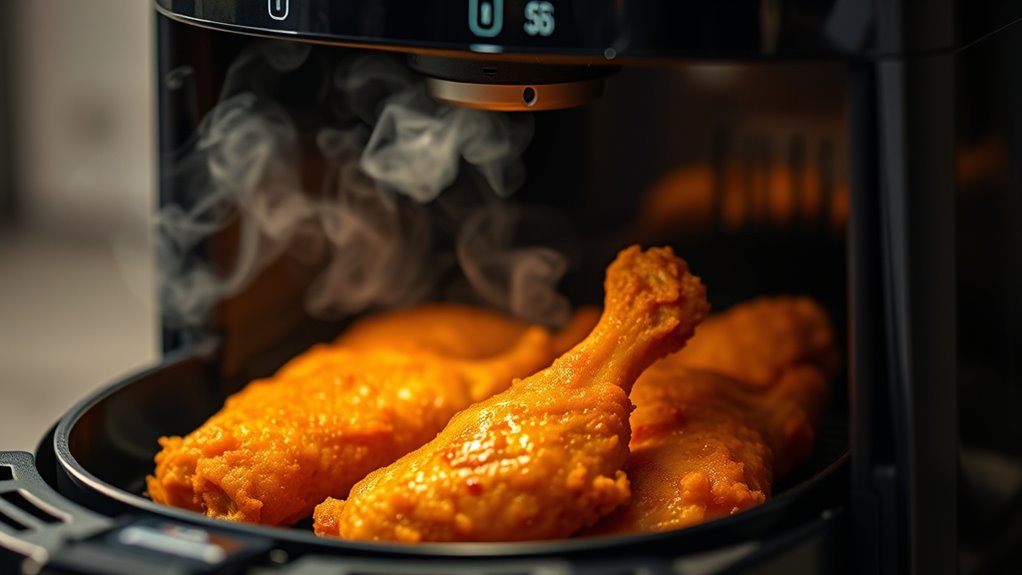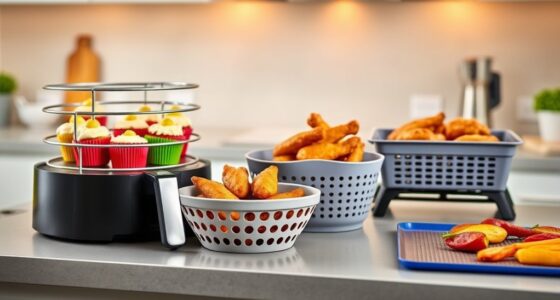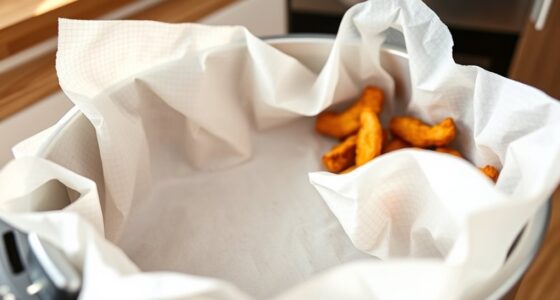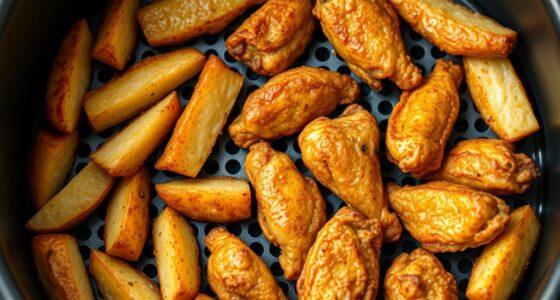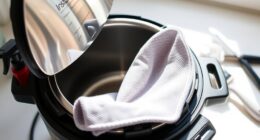To prevent smoke when cooking fatty foods in your air fryer, trim excess fat, line the basket with parchment or foil, and avoid covering it completely to maintain airflow. Use recommended temperatures and lower the heat if smoke appears. Regularly clean your air fryer to prevent grease buildup and consider placing a small amount of water in the bottom tray to reduce splatter. Good ventilation also helps keep smoke at bay—keep exploring for more tips.
Key Takeaways
- Trim excess fat from foods to reduce dripping and prevent grease splatter.
- Use recommended temperatures and lower heat if smoke begins to form.
- Line the basket with parchment or foil, leaving space for airflow to minimize grease buildup.
- Regularly clean the air fryer, especially the heating element, to prevent grease accumulation.
- Ensure proper ventilation by opening windows or using an exhaust fan during cooking.
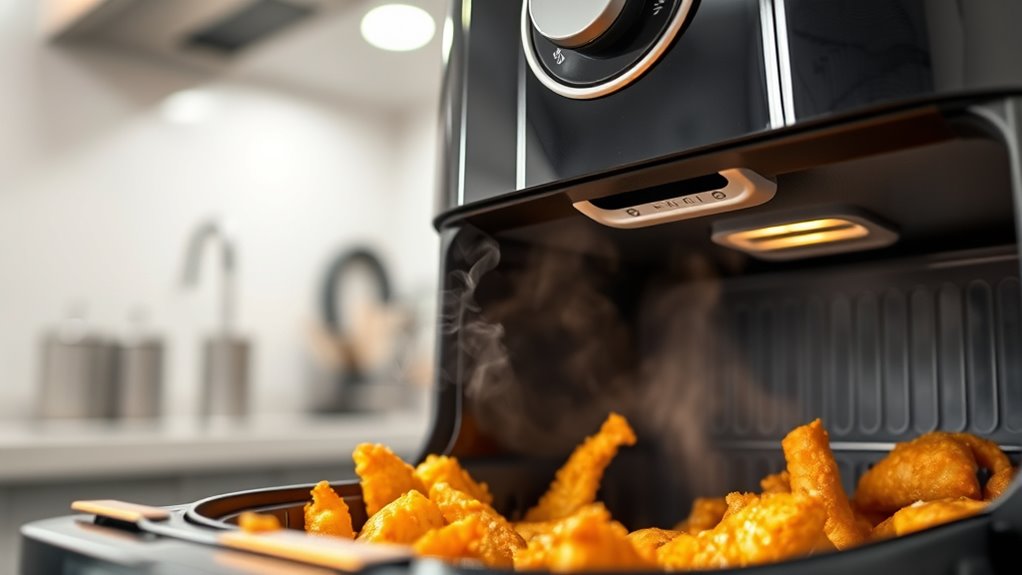
Cooking fatty foods in your air fryer can often lead to smoke, but with the right techniques, you can prevent this from happening. One of the main issues is grease splatter, which occurs when excess fat drips onto the heating element or the basket’s bottom, causing smoke and potential fire hazards. To minimize grease splatter, start by trimming excess fat from your foods. Removing large deposits of fat reduces the amount that can drip and burn, keeping your air fryer cleaner and smoke-free. Additionally, lining the basket with parchment paper or aluminum foil can catch grease before it hits the heating element. Just be sure to leave enough space for air circulation so your food cooks evenly, and avoid covering the entire basket, which can restrict airflow.
Trim excess fat and line the basket to prevent grease splatter and smoke during air frying.
Implementing effective smoke reduction techniques also involves controlling the temperature. Cooking at excessively high heat can cause fat to burn quickly, leading to smoke. Stick to recommended cooking temperatures for fatty foods, and if you notice smoke forming early, lower the heat slightly. Preheating your air fryer properly helps ensure even cooking and reduces the chances of fat burning. When cooking particularly greasy items, consider placing a small amount of water in the bottom of the basket or tray, if your model allows. This creates a barrier that prevents grease from directly contacting the heating element and reduces smoke.
Another tip is to regularly clean your air fryer. Grease buildup on the walls and heating element can ignite during cooking, producing smoke. After each use, allow the air fryer to cool, then wipe down the interior with a damp cloth or sponge, focusing on the heating element and basket. Deep cleaning with a non-abrasive cleaner once a month keeps grease from accumulating and minimizes smoke during subsequent uses. Regular use of a high-quality airless paint sprayer can also help keep your appliance in top condition by ensuring even application and easier cleaning.
Finally, ventilation plays an essential role. Always cook in a well-ventilated area—open windows or turn on the exhaust fan—to help dissipate any smoke that does occur. If your air fryer has a smoke alarm nearby, consider temporarily disabling it during high-fat cooking sessions, just to prevent false alarms, and turn it back on afterward. By combining grease splatter prevention, temperature control, regular cleaning, and proper ventilation, you can considerably reduce smoke and enjoy cooking your favorite fatty foods with less mess and worry.
Frequently Asked Questions
Can Using a Splash of Vinegar Reduce Smoke During Frying?
Using a splash of vinegar can help with smoke reduction techniques, but its effectiveness is limited. Vinegar may slightly reduce smoke by acting as a mild degreaser, but it won’t markedly prevent smoke when cooking fatty foods. For better results, focus on proper air fryer ventilation, removing excess grease, and avoiding overcrowding. Combining these methods offers a more reliable way to minimize smoke during frying.
Does Adding a Water Tray Prevent Smoke Buildup?
Adding a water tray can considerably help with smoke prevention in your air fryer. When you place water in the tray, it creates steam that keeps the grease and drippings from burning and producing smoke. This simple step helps maintain a cleaner cooking environment and reduces smoke buildup. Just ensure you don’t overfill the tray, and replace the water regularly for best results.
Are There Specific Oils That Produce Less Smoke?
You’ll notice some oils are like firebreaks for smoke, producing far less when heated. Opt for oils with high smoke points, like avocado, refined safflower, or light olive oil, to keep smoke at bay. These oils withstand high temperatures without burning, unlike lower smoke point oils that turn smoky quicker. Choosing the right oil based on smoke point is your best bet to keep your air frying smoke-free.
How Often Should I Clean the Air Fryer to Prevent Smoke?
You should clean your air fryer after every 3-4 uses to maintain ideal performance and prevent smoke. Regular air fryer maintenance involves removing grease and food residue, which are common causes of smoke during cooking. Use a soft brush or cloth to clean the basket and tray, and check the heating element for buildup. These smoke prevention techniques keep your air fryer functioning well and reduce smoky odors.
Can Pre-Soaking Fatty Foods Reduce Smoke During Cooking?
Pre-soaking fatty foods can help reduce smoke during cooking, as it decreases the amount of excess oil that drips and burns. Managing oil temperature by setting the air fryer to an appropriate level also minimizes smoke. Additionally, using kitchen ventilation techniques like opening windows or turning on a range hood helps clear smoke quickly. Combining pre-soaking with these practices guarantees a cleaner, smoke-free cooking experience.
Conclusion
By following these tips, you can enjoy crispy, delicious fatty foods without the smoke chaos. Keep your air fryer clean, avoid overcrowding, and monitor the temperature closely. Remember, a penny saved is a penny earned—so take these simple steps to prevent smoke and keep your kitchen fresh. With a little care, you’ll master the art of smoke-free frying, proving that prevention is better than cure. Happy cooking!
